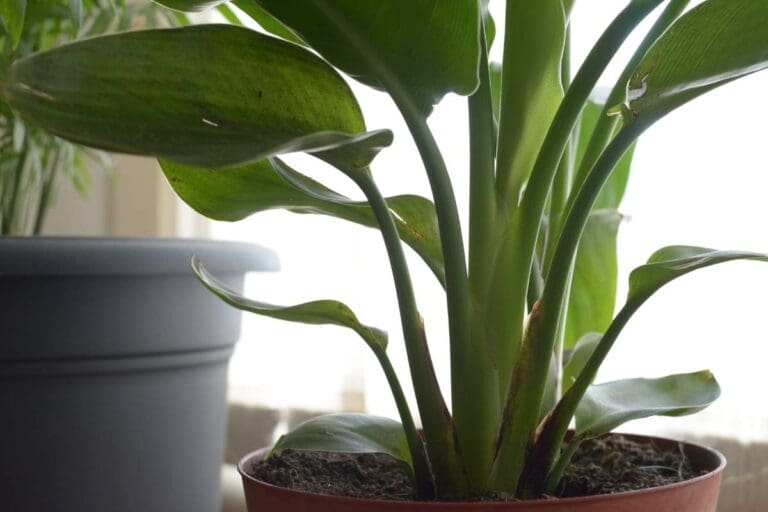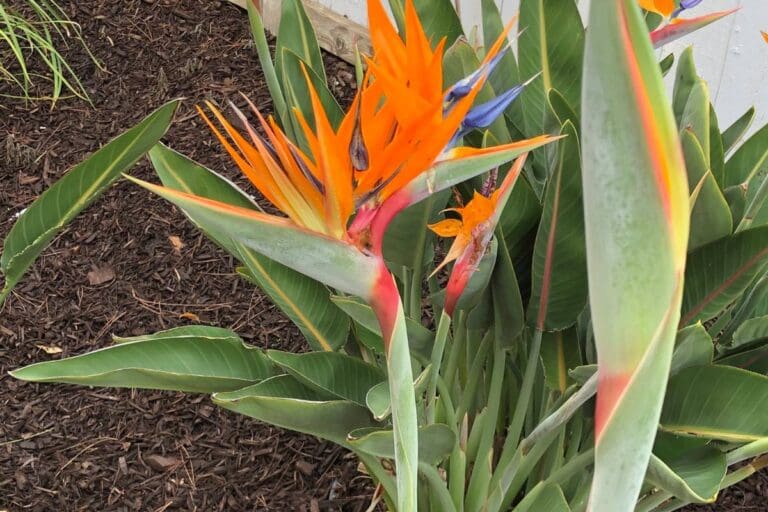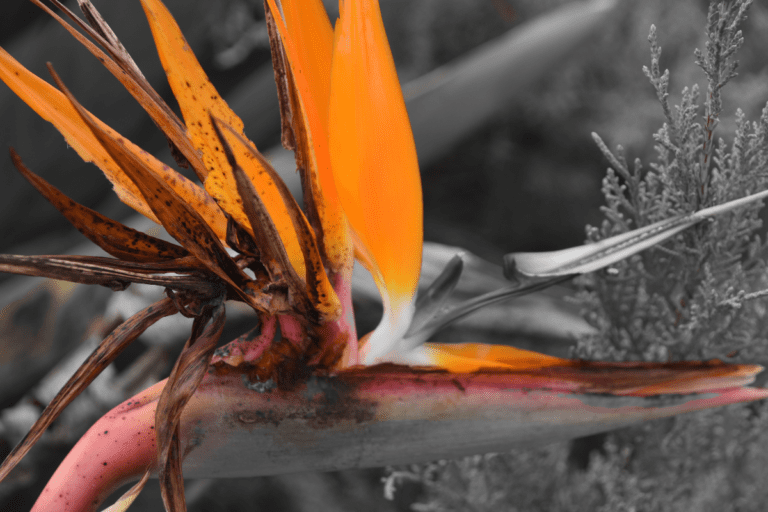Why Is My Bird of Paradise Leaning? (9 Causes+Fix)
As a bird of paradise grows huge without support, it becomes more prone to leaning. However, this is one of the primary causes, but there are many other reasons too.
If your bird of paradise is leaning to one side, the most common causes can be a lack of pruning, improper light, root-bound, or lack of proper growing conditions. Inspect the plant thoroughly and find the exact reason. Then treat the plant and provide the right conditions.
I have also seen my houseplants leaning because of several reasons. This issue is quite common. Not treating your plant from leaning can even break the stems. So, in this article, I will help you by listing all the possible causes and solutions that cause the leaning of a bird of paradise plant.

Please note: Simplify Plants is reader-supported. Some links in the post are affiliate links and I get a commission from purchases made through links in the post.
Common reasons why your bird of paradise plants may lean
Nine common reasons are there behind a leaning bird of paradise plant.
1. Lack of pruning
Leaves play an essential role in absorbing energy from the sunlight.
Some plants shed their old leaves automatically.
But in the case of the bird of paradise, the leaves don’t fall even after years.
So, it needs to be pruned frequently.
Because of the lack of pruning, the plant keeps growing huge.
Due to heavy foliage, the stems start to lean and break if left untreated.
2. Inadequate light
Low and excessive light can cause the bird of paradise to lean. How?
If the bird of paradise is exposed to direct sunlight for a prolonged period, the plant loses water from every part due to increased transpiration.
This causes the plant to lean because of dehydration.
While on the other hand, if the bird of paradise is not getting sufficient light, it starts craving it, so the plant starts to lean towards the light gradually.
3. Root-bound plant

I know you have heard that bird of paradise likes to be root-bound.
But this statement is valid only to some extent.
If the bird of paradise is not re-potted after 1.5 to 2 years, the roots will fail to get sufficient space to grow further and stop growing altogether.
This results in the plant leaning because of a lack of moisture and nutrients.
Lift the container and inspect whether the roots are coming from the drainage holes.
If yes, it means the plant is root bound.
4. Shock
Shock is the most common reason why your bird of paradise is leaning.
The plant can get a shock if you bought it from a shock, transplanted from outdoor to indoor, or repotted your bird of paradise.
But why it happens?
If the bird of paradise is suddenly introduced to a new environment, it becomes difficult to adjust to that habitat.
This creates shock, and the plant starts leaning.
But there is nothing to worry about.
A plant going on a shock is very normal.
The bird of paradise will automatically recover after a few weeks of care.
5. Inadequate fertilization
Most people think fertilizing their indoor plants is not essential.
But this misconception can cause extreme harm to their plants.
Due to under fertilization, lack of nutrients will pressure the plant to maintain good health.
Hence, the bird of paradise starts leaning because of weakness.
So, if you think fertilizing is unnecessary, change your habit and provide proper nutrients to your bird of paradise.
6. Incorrect watering

Incorrect watering means either you are watering too little or excessively.
Underwatering makes the bird of paradise dehydrated and weak due to inadequate moisture in the leaves and stems.
This causes the plant to lean.
While overwatering is considered more dangerous than underwatering.
This is because the plant can suffer from root rot.
Root rot occurs when fungal diseases grow inside the soil because of staying in water for too long.
Because of this, the roots stop working, the plant doesn’t receive the required minerals and moisture, and it starts leaning.
7. Pest infestations
Pest infestations are the most common cause of every problem.
Similarly, it contributes to leaning too.
The most common pests in birds of paradise are mealybugs, spider mites, aphids, scales, and white flies.
But what do they do?
Pests ingest the sap from the plant’s part, leaving it completely weak.
Hence, the bird of paradise starts leaning because it fails to hold up the situation for too long and gives up after weeks of struggling.
8. Temperature and humidity stress

This plant doesn’t like staying in lower temperatures below 60°F during winter and higher temperatures above 100°F during summer.
Extreme lower or higher and sudden temperature fluctuations can create stress for the bird of paradise, which causes the plant to lean.
Similarly, if the humidity is too less around the bird of paradise, the plant frequently suffers from dehydration which causes it to lean.
9. Wrong soil
Using the wrong soil for your bird of paradise can create a big issue.
If the soil you use is highly compact, the bird of paradise will frequently suffer from waterlogging, leading to overwatering.
Due to this, the plant starts leaning.
But if the soil is too loose, the water will drain too fast without letting the roots absorb moisture and nutrients properly, which results in the plant leaning.
How to treat the causes that affect the bird of paradise plant leaning?
Let’s discuss the treatment of each cause which can help your bird of paradise straighten back as before.
1. Proper pruning techniques for a bird of paradise

If your bird of paradise is leaning because of a lack of pruning, you must cut back all the excess foliage.
Let’s discuss the step-by-step procedure on how to prune correctly.
Equipment you will require:
- Disinfected pruners
- Safety gloves and glasses
- Rubbing alcohol
Steps:
- Sterilize the pruners with rubbing alcohol first.
- Then, check how many leaves are required to be pruned. To inspect the older foliage, look for droopy and split structures.
- If the condition is messy or heavy, try not to trim more than 25% of the leaves to avoid stress.
- Then, grab your pruner and trim the leaf’s stem close to the base. This will promote efficient growth.
- Always do a clean cut and make sure not to tear the stems.
- Put cinnamon paste or powder on the cut to prevent infections.
- Then, throw all the trimmed leaves, wash the pruners, and provide proper care to the bird of paradise.
- You can again start pruning the remaining leaves after 1 week.
2. Providing proper light
Both low and excessive light can cause the plant to lean.
Low light
Keep the bird of paradise in the closest source of light.
The perfect location is west and east-facing windows.
To provide light in every direction, rotate the bird of paradise frequently.
If you are struggling to provide natural light, then use artificial lights.
Bird of paradise takes time to lean because of the lack of light.
So, if you notice the plant is leaning suddenly, then low light is not likely to be the cause.
Excessive light
Trim the burnt and scorched leaves first to treat the plant from excessive light.
Then, water the plant gradually to reduce the stress from extreme heat.
Change the location of the bird of paradise where it will receive indirect light.
To decrease the light intensity, provide a shade with sheer curtains.
Always keep the place 5 to 6 feet away from the windows to avoid stress.
Then, in the end, mulch the soil surface to keep the soil hydrated all the time.
3. Repotting for fixing root-bound

If your bird of paradise is root-bound, you must repot the plant to recover.
Choose a pot 2-3 inches bigger than the previous pot and prepare a fresh soil mix.
To remove the plant from the current pot, you must first water the soil to loosen the structure.
Then, you can slowly pull out the plant and remove all the soil, untangle the roots, and trim all the damaged roots.
After that, you can repot the bird of paradise in the new pot.
Ensure you always do the repotting only during the growing season, i.e., spring and summer.
4. Recovering from a shock
Generally, the bird of paradise will automatically recover from a shock after adjusting to the new environment.
But even if it doesn’t, it means you are not adequately caring for your plant.
Inspect your plant to see what is missing.
Try to provide the same environment as it was growing before.
Keep the plant in the exact location after repotting.
Provide proper watering and light.
Also, maintain the ideal temperature for a bird of paradise.
Never ignore your plant’s basic needs. I never do this, nor should anyone.
5. Providing fertilizers

You will have to fertilize the bird of paradise to treat the plant from nutrient deficiencies.
There are 3 types of fertilizers that you can provide, i.e., granular, liquid, and spikes fertilizers.
The NPK ratio you should maintain is 10:10:10.
- Granular fertilizers: You can apply this by sprinkling it into the soil surface. Here, the nutrients are slowly released into the soil.
- Liquid fertilizers: You can apply this by diluting the fertilizers with water. It is the most suitable method to provide nutrients instantly to the soil.
- Spikes fertilizers: It is a type of fertilizer that comes in spikes. You will just have to push down the spikes into the soil to apply. It is also a slow-release fertilizer that provides nutrients slowly.
Try to provide fertilizer every month only during the growing season.
6. Fixing watering problems
Let’s discuss the solution to both problems separately:
Fixing underwatering
First, trim the injured leaves with pruners.
Then, thoroughly water the bird of paradise until it drains out from the drainage holes.
But water the plant little by little.
I never water my houseplant at a vast volume directly into the soil.
I always give some time for my houseplant so that it will get adjusted properly.
Ensure your bird of paradise is not receiving direct sunlight to avoid underwatering problems frequently.
After some time, you will notice your bird of paradise is getting upright.
Fixing overwatering
A plant leaning from overwatering means it is suffering from root rot disease.
The only option for fixing this is repotting.
- Slowly remove the plant from the pot and inspect the root’s condition.
- Give a shower to the root system with water to remove the soil from it.
- Then, prune the infected roots with sterilized pruners.
- After trimming, dip the healthy roots in a hydrogen peroxide solution or fungicide to destroy all the bacteria.
- Select a container bigger than the old one. Make sure it has good drainage holes too.
- Repot the bird of paradise in the new container using fresh well-draining soil mix and place it in bright indirect sunlight.
- Avoid soggy soil and inspect the soil’s moisture level before watering the plant.
7. Getting rid of pests

First, cut back all the infected parts of your bird of paradise with pruners.
Then, Keep your plant far away from other houseplants.
Then, wear gloves and remove all the visible pests which your hands.
After that, provide a strong shower to eliminate the remaining pests.
Even if the pests are stuck, immerse cotton swabs into the rubbing alcohol and rub on the infected parts.
After the treatment, you can apply dish wash or insecticidal soap to the entire plant.
To prevent future infestations, apply biological pesticides every 2-3 weeks.
8. Maintaining temperature and humidity
Any change in the bird of paradise’s natural habitat can cause the plant to lean.
Let’s discuss how you can fix this problem.
Temperature
The suitable temperature of a bird of paradise is 65-85°F.
Inspect the temperature with the help of a digital thermometer.
Then, you can easily adjust the temperature by using a thermostat device.
Don’t keep the plant near frequently open and closed windows or doors to avoid temperature fluctuations.
Also, avoid keeping the plant near frosty windows and heating objects.
Humidity
First, check the humidity level with the help of a hygrometer.
Then you can follow the 6 steps given below:
- You can spray the bird of paradise with water to temporarily increase humidity.
- You can place other moisture-loving houseplants with birds of paradise.
- You can place 3-4 water bowls around the bird of paradise.
- You can apply the pebble tray technique for your bird of paradise. Take a tray filled with water and pebbles and place the plant on it.
- I also place my houseplants inside the washroom for hours as the humidity stays high.
- If these methods are too complicated, you can use a humidifier device whenever possible.
9. Correcting the soil
To correct the soil, you must either add amendments to the current soil or change the entire soil.
To reduce soil compactness, you can apply manure, sand, gypsum powder, perlite, coco husk hips, and crushed charcoal to the current soil.
To increase moisture retention, apply vermiculite, peat moss, compost, and clay soil to the current soil.
But don’t you think changing the entire soil is the best option?
I know the procedure is quite complicated, but trust me, it is worth it.
Mix half of the potting soil, half of the peat moss, and some perlite.
Then, repot the entire bird of paradise using this soil.
How to properly support the bird of paradise?

There are 2 things you should do to support your bird of paradise.
- Supporting the plant with stakes
- Pruning the top part of the plant
Providing support with the help of stake
To prevent the bird of paradise from leaning, you can use stakes.
Let’s discuss how you can support your plant with it:
- Take 4-5 stakes that are taller than your bird of paradise.
- You will also need a strap to keep the stakes attached to the stems.
- Place the stake at the back of the leaning stem and press it inside the soil. This provides excellent support to the stems.
- You can use one stake for each if too many stems are leaning.
- Then, take the rubber strap and bind the stem with the stake.
- Keep inspecting the strap to notice if it has become tight. If it’s tight, lose the strap so it will not interrupt the growth.
Pruning the top part of the plant
To recover the plant from leaning, prune the top part of the bird of paradise.
This will help the plant to stand straight.
Take a pruner and cut the top part of the plant’s stem, which is leaning.
Also, cut back all the droop and split leaves to encourage new growth.
Following this practice will not pressurize the bird of paradise to lean because of heaviness.
Final words
When I saw my houseplant was leaning, I inspected it and found that I was not correctly pruning it. I pruned it correctly and supported it with stakes for a while, and it was healthy and straight again.
Similarly, ignoring the basic needs of your bird of paradise can cause the plant to lean. So, regularly inspect your plant and maintain proper health to prevent this issue. This is not a big issue as recovering the plant from leaning is easier than other issues.
How much time your bird of paradise can take to recover from leaning?
You will notice your bird of paradise is getting upright within 2-3 weeks. The plant will completely get back to its normal health after 1 month.
What is the best time to prune your bird of paradise?
You must do the pruning only during the growing season, i.e., spring and summer. Never disturb your bird of paradise during winter, as it can cause stress.
Reference: Wikipedia
Recommended Garden Supplies
| Product Image | Our Recommended Gardening Supplies | Check Offers! |
|---|---|---|
Top Top
Top
Top
Top
Top
Top
Top
Top | rePotme Houseplant and Tropical Classic Potting Soil Mix | Check Offer On Amazon |
 Top
Top
Top
Top
Top
Top
Top
Top | Espoma Organic Indoor Plant Food | Check Offer On Amazon |
 Top
Top
Top
Top
Top
Top
Top
Top | GooingTop LED Grow Light 6000K Full Spectrum Clip Plant Growing Lamp | Check Offer On Amazon |
 Top
Top
Top
Top
Top
Top
Top
Top | Soil Moisture Meter | Check Offer On Amazon |
 Top
Top
Top
Top
Top
Top
Top
Top | Govee Hygrometer Thermometer, Bluetooth Enabled! | Check Offer On Amazon |
 Top
Top | LEVOIT Humidifiers for Large Room(Best For Plants) | Check Offer On Amazon |
 Top
Top
Top
Top
Top
Top
Top
Top | Upgraded DIY Automatic Drip Irrigation Kit, 15 Potted Houseplants Support | Check Offer On Amazon |
 Top
Top
Top
Top
Top
Top
Top
Top | Stainless Steel Heavy Duty Gardening Tool Set | Check Offer On Amazon |
 Top
Top
Top
Top
Top
Top
Top
Top | Bonide Insecticidal Soap | Check Offer On Amazon |
 Top
Top
Top
Top
Top
Top
Top
Top | Bonide 32 oz Spray Neem Oil for Organic Gardening | Check Offer On Amazon |
 Top
Top
Top
Top
Top
Top
Top
Top | Garden Safe Fungicide | Check Offer On Amazon |






Its like you read my mind! You appear to know so much about this, like you wrote the book in it or something. I think that you can do with a few pics to drive the message home a little bit, but other than that, this is fantastic blog. A great read. I’ll certainly be back.